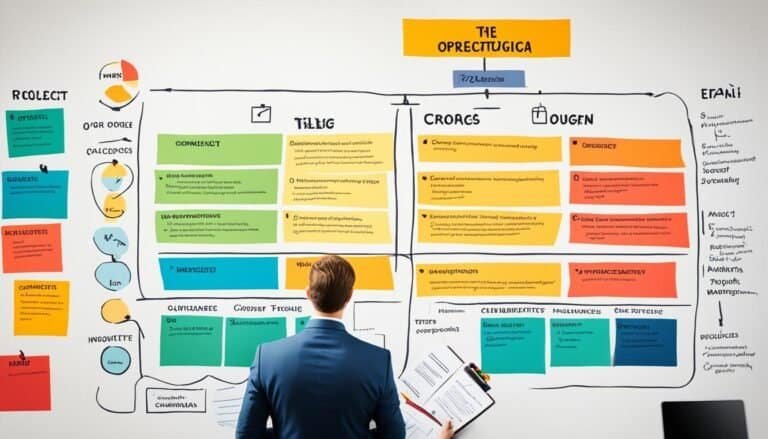Stakeholder Analysis: Understanding Influences on Your Project
Stakeholder analysis is a critical process in project management that allows project managers to gain a comprehensive understanding of the various individuals and groups who have an interest in or may be affected by a project. By identifying key stakeholders and analyzing their needs, expectations, influence, and power, project managers can effectively manage stakeholder relationships, mitigate risks, and address concerns.
However, the true value of stakeholder analysis lies in its ability to maximize project success through stakeholder engagement. But what exactly does this mean? How can understanding the influences of stakeholders contribute to the success of a project?
In this discussion, we will explore the importance of stakeholder analysis and delve into the strategies and benefits of effectively engaging stakeholders throughout the project lifecycle.
Key Takeaways
- Stakeholder analysis is crucial in project management as it helps identify individuals and groups that influence project success.
- Effective stakeholder engagement is essential for project success and can be fostered through proactive and ongoing communication.
- Tailoring communication channels and messages to stakeholder needs, as well as utilizing various mediums like emails, newsletters, and social media, can help engage a wider audience.
- Understanding stakeholder needs and expectations, as well as assessing their influence and power dynamics, is essential for project success and effective stakeholder engagement.
The Importance of Stakeholder Analysis
Stakeholder analysis is a crucial process in project management, as it enables organizations to identify and understand the various individuals and groups that can significantly influence the project's success. Effective stakeholder engagement is essential for project success and requires a clear understanding of the role of communication in stakeholder analysis.
Communication plays a pivotal role in stakeholder analysis as it facilitates the exchange of information, ideas, and expectations between project stakeholders. By establishing open and transparent lines of communication, project managers can ensure that stakeholders are well-informed and actively involved in the decision-making process. This fosters a sense of ownership and commitment among stakeholders, increasing the likelihood of their support and cooperation throughout the project.
Strategies for effective stakeholder engagement involve proactive and ongoing communication. It is essential to identify key stakeholders and tailor communication channels and messages to their specific needs and preferences. Regular meetings, workshops, and feedback sessions can provide opportunities for stakeholders to voice their concerns, provide input, and stay updated on project progress.
Additionally, utilizing various communication mediums such as emails, newsletters, and social media platforms can help reach a wider audience and ensure that stakeholders are informed and engaged.
Identifying Key Stakeholders
To effectively identify key stakeholders, project managers must have a comprehensive understanding of the individuals and groups that hold significant influence over the project's outcomes. This process is known as stakeholder mapping, which involves identifying and analyzing stakeholders based on their level of interest, power, and influence. By conducting a thorough stakeholder analysis, project managers can prioritize their engagement efforts and ensure that the right stakeholders are involved in decision-making processes.
Here are four important steps to consider when identifying key stakeholders:
- Identify internal stakeholders: These are individuals or groups within the organization who have a direct interest in the project's success, such as executives, managers, and employees. Their support and involvement are crucial for the project's implementation.
- Identify external stakeholders: These are individuals or groups outside the organization who may be affected by the project or have an interest in its outcomes. Examples include customers, suppliers, regulatory bodies, and community organizations.
- Assess stakeholder power and influence: Determine the level of power and influence each stakeholder holds over the project. This will help project managers prioritize their engagement efforts and allocate resources accordingly.
- Develop stakeholder engagement strategies: Based on the stakeholder analysis, project managers can tailor their communication and engagement strategies to effectively involve key stakeholders. This may include regular meetings, workshops, surveys, and other means of gathering feedback and fostering collaboration.
Analyzing Stakeholder Needs and Expectations
Understanding the needs and expectations of stakeholders is essential for project success and effective decision-making. Analyzing stakeholder engagement and implementing appropriate stakeholder communication strategies can help ensure that their needs and expectations are met. It is important to identify key stakeholders and their roles in the project, as well as their level of influence and interest. This information can be organized in a stakeholder analysis table, which presents a clear overview of stakeholders and their needs.
| Stakeholder | Role in Project | Level of Influence | Level of Interest |
|---|---|---|---|
| Project Sponsor | Provides funding and resources | High | High |
| Project Manager | Oversees project execution | High | High |
| Team Members | Execute project tasks | Low-Medium | High |
| Clients | Receives project deliverables | Low-Medium | High |
| End Users | Utilizes project output | Low-Medium | Medium |
| Regulatory Bodies | Sets project guidelines and standards | High | Low |
| Competitors | Potential impact on project success | Low | Low |
| Community | Affected by project outcomes | Low-Medium | Low |
| Suppliers | Provides necessary resources | Low | Medium |
Assessing Stakeholder Influence and Power
When assessing stakeholder influence and power, it is important to consider stakeholder power dynamics and analyze the level of influence each stakeholder holds.
Stakeholder power dynamics refer to the relationships and interactions among stakeholders that shape their ability to influence project outcomes.
Analyzing stakeholder influence involves evaluating the extent to which stakeholders can affect project decisions, resources, and outcomes.
Stakeholder Power Dynamics
The assessment of stakeholder influence and power is crucial in understanding stakeholder power dynamics within a project. By analyzing the different levels of influence and power held by stakeholders, project managers can identify potential power struggles and foster stakeholder collaboration more effectively.
Here are four key factors to consider when assessing stakeholder influence and power:
- Position and Authority: Stakeholders with higher positions and authority within the organization often have more power to influence project decisions and outcomes.
- Expertise and Knowledge: Stakeholders with specialized knowledge or expertise relevant to the project can wield significant influence over project direction and decision-making.
- Resources and Control: Stakeholders who control critical resources or have the ability to allocate resources can exert considerable power over the project's progress and success.
- Relationships and Networks: Stakeholders with strong relationships and extensive networks can leverage their connections to influence project outcomes and gain support from other stakeholders.
Understanding these power dynamics can help project managers navigate stakeholder interactions and ensure effective stakeholder engagement throughout the project lifecycle.
Analyzing Stakeholder Influence
To effectively analyze stakeholder influence and power, project managers must consider various factors such as position and authority, expertise and knowledge, resources and control, and relationships and networks. By understanding these factors, project managers can develop effective stakeholder mapping and engagement strategies. Stakeholder mapping involves identifying and categorizing stakeholders based on their level of influence and power. This helps project managers prioritize their engagement efforts and tailor communication strategies accordingly. Stakeholder engagement strategies, on the other hand, involve actively involving stakeholders in the project and seeking their input, feedback, and support. This can be done through regular meetings, workshops, surveys, and other forms of communication. By analyzing stakeholder influence and power and implementing appropriate engagement strategies, project managers can ensure that stakeholders are effectively managed and their interests are taken into account throughout the project lifecycle.
| Factors | Description |
|---|---|
| Position and Authority | This refers to the formal role and level of authority a stakeholder holds within the organization or project. Stakeholders with higher positions and authority tend to have greater influence and power. |
| Expertise and Knowledge | Stakeholders with specialized knowledge, skills, or expertise in relevant areas can have significant influence and power. Their input and recommendations are often highly valued in decision-making processes. |
| Resources and Control | Stakeholders who have control over key resources, such as budget, staff, or infrastructure, can exert influence and power over the project. They can allocate resources strategically and make decisions that impact the project's success. |
| Relationships and Networks | Stakeholders who have strong relationships and networks within the organization or industry can leverage these connections to influence project outcomes. They can mobilize support, build alliances, and navigate organizational politics to shape decision-making processes.
Managing Stakeholder Relationships
Developing strong relationships with stakeholders is a vital component of effective project management. By establishing trust and employing effective communication strategies, project managers can ensure the support and cooperation of stakeholders throughout the project lifecycle.
Here are four key strategies for managing stakeholder relationships:
- Identify key stakeholders: It is crucial to identify all individuals or groups who have a vested interest in the project. This includes internal stakeholders such as team members and executives, as well as external stakeholders such as clients, suppliers, and regulatory bodies.
- Understand stakeholder expectations: Take the time to understand the needs, concerns, and expectations of each stakeholder. This will help in aligning project objectives with their goals and ensuring their satisfaction.
- Establish open and transparent communication channels: Regular and clear communication is essential for building trust and maintaining positive relationships with stakeholders. Utilize a variety of communication methods such as meetings, emails, and progress reports to keep stakeholders informed and involved.
- Proactively manage conflicts: Conflicts are inevitable in project management. It is important to anticipate and address potential conflicts early on, by actively listening to stakeholders' concerns and finding mutually beneficial solutions.
Mitigating Risks and Addressing Concerns
Building upon the foundation of strong stakeholder relationships, project managers must now focus on mitigating risks and addressing concerns to ensure the successful execution of the project.
Mitigating risks involves identifying potential threats and taking proactive measures to minimize their impact on the project. This includes conducting risk assessments, implementing risk mitigation strategies, and regularly monitoring and evaluating risks throughout the project lifecycle.
Addressing concerns, on the other hand, involves actively listening to stakeholders, understanding their perspectives, and taking appropriate actions to address their worries or objections. Project managers should create open lines of communication to encourage stakeholders to voice their concerns and provide timely responses to address them. This can help build trust and maintain positive relationships with stakeholders.
To effectively mitigate risks and address concerns, project managers should develop a comprehensive risk management plan and a stakeholder engagement plan. The risk management plan outlines the strategies and processes for identifying, assessing, and responding to risks, while the stakeholder engagement plan outlines the strategies for engaging stakeholders and addressing their concerns.
Maximizing Project Success Through Stakeholder Engagement
Maximizing project success relies heavily on effective stakeholder engagement and communication strategies. A project's success is not solely determined by its deliverables, but also by the level of engagement and collaboration with stakeholders throughout the project lifecycle.
Here are four stakeholder communication strategies and engagement techniques that can help maximize project success:
- Clear and Transparent Communication: Establish open lines of communication with stakeholders from the beginning. Provide regular updates, share project progress, and ensure that stakeholders are well-informed about any changes or challenges. This fosters trust and keeps stakeholders engaged and invested in the project's success.
- Active Stakeholder Involvement: Involve stakeholders in decision-making processes and seek their input and feedback. This helps ensure that their perspectives are considered and increases their ownership of the project. Regular meetings, workshops, and collaborative sessions can facilitate this active involvement.
- Tailored Communication Approach: Understand the unique needs and preferences of different stakeholders and adapt your communication style accordingly. Some stakeholders may prefer face-to-face meetings, while others may prefer emails or online platforms. Tailoring your communication approach enhances stakeholder engagement and facilitates effective communication.
- Stakeholder Relationship Management: Develop strong relationships with stakeholders by understanding their interests, concerns, and objectives. Regularly engage with them, address their concerns, and demonstrate that their feedback is valued. Building strong relationships fosters trust and promotes a collaborative project environment.
Conclusion
In conclusion, stakeholder analysis is a vital tool for project success.
By identifying key stakeholders, understanding their needs and expectations, assessing their influence and power, and managing relationships, project managers can mitigate risks and address concerns effectively.
Engaging stakeholders throughout the project can maximize success and ensure project goals are achieved.
With careful analysis and strategic engagement, projects can navigate the complex web of stakeholder influences and thrive.







